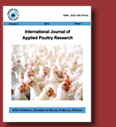|
|
|
|
|
|
|
|
Biosecurity practices and occurrence of rabbit hemorrhagic disease in
southern Benin
|
|
Mensah SEP1, Atchadé GST1, Montcho M2,
Adjahoutonon KYKB1*, Lahamy O1, Koudandé OD1,
Mensah GA1 |
|
1Center
of Agricultural Research of Agonkanmey, National Institute of
Agricultural Researches of Benin (INRAB), 01 BP 884 Recette Principale,
Cotonou 01, Republic of Benin; 2Animal Science Research
Laboratory, Faculty of Agronomic Sciences, University of Abomey-Calavi,
01 BP 526 Cotonou 01, Republic of Benin |
| |
| Abstract |
|
Rabbit production in Benin has been seriously affected by many outbreaks
of Rabbit Haemorrhagic Disease between 1995 and 2015 which continue to
be a major constraint for this activity. A cross sectional survey was
done from October to November 2018 in Research and Development Sites of
southern Benin
to carry out the typology of rabbit farms considering biosecurity
practices and vaccination against RHD and determine the influence of
each type of rabbit farms on RHD occurrence. Forty rabbit farms
were randomly sampled
in
height sites located respectively in municipalities of Kétou, Adjohoun,
Sèmè-Podji, Tori-Bossito, Grand-Popo, Djakotomè, Zogbodomey and Sakété.
Blood samples were randomly collected by ear vein from one buck,
two does and two growing rabbits from each of the sampled farms for
antibodies against both RHDV and RHDV2 detection by competitive ELISA.
Factor Analysis of Mixed Data and Hierarchical Clustering on Principal
Components were performed for farm typology and
quasipoisson model was run to check the influence of farm types on RHD
occurrence.
Surveyed rabbit farmers were mostly men (94.74%), are 45±13 years old in
average, had secondary school (36.84%) or university (36.84%) level.
They were very often monogamous (68.42%) and owned 111±118 rabbits in
average. Three groups of similar farms had been identified:
Group 1 and 3 characterized by disinfection of building and materials
and use of footbaths with effective disinfectants, droppings collection,
buildings cleaning and respectively not polygamous households and modern
buildings; group 2 where farmers did not disinfect cages, buildings or
feeders and waterers and did not use footbath, had polygamous household
and did not have high education level. All the rabbits in surveyed farms
were free from antibodies against the two variants RHDV1 and RHDV2 of
RHD at the time of the study. Otherwise, RHD cases since 2015 were lower
in farms in group 2 than in farms in groups 1 and 3. As biosecurity
practices were better in groups 1 and 3 than in group 2, it may be
inferred that the farms which have more previous cases of RHD observe
more biosecurity measures.
|
|
Keywords:
RHD, rabbit farms, typology, southern Benin |
| |
| To cite this article:
Mensah SEP, Atchadé GST, Montcho M, Adjahoutonon KYKB, Lahamy O,
Koudandé OD, Mensah GA,
2019.
Biosecurity practices and occurrence of rabbit hemorrhagic disease in
southern benin.
Res.
Opin. Anim. Vet. Sci., 9(1): 21-27. |
|
|

